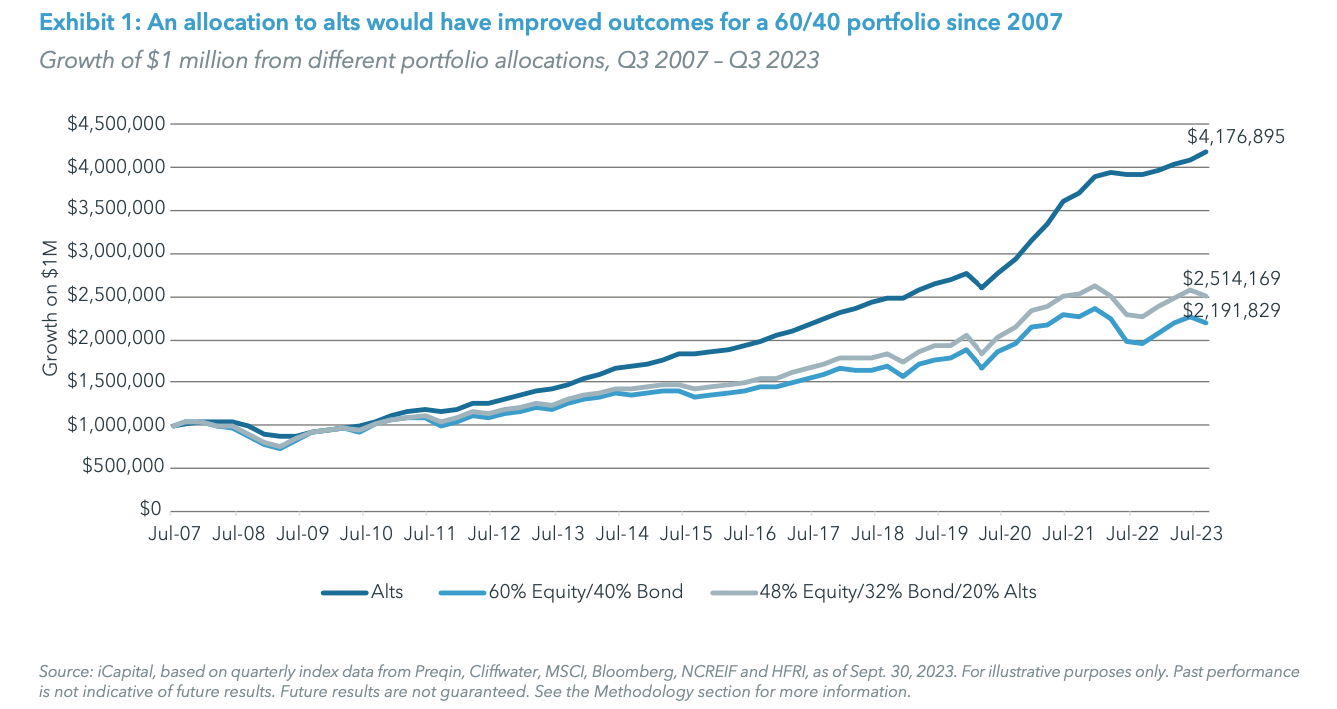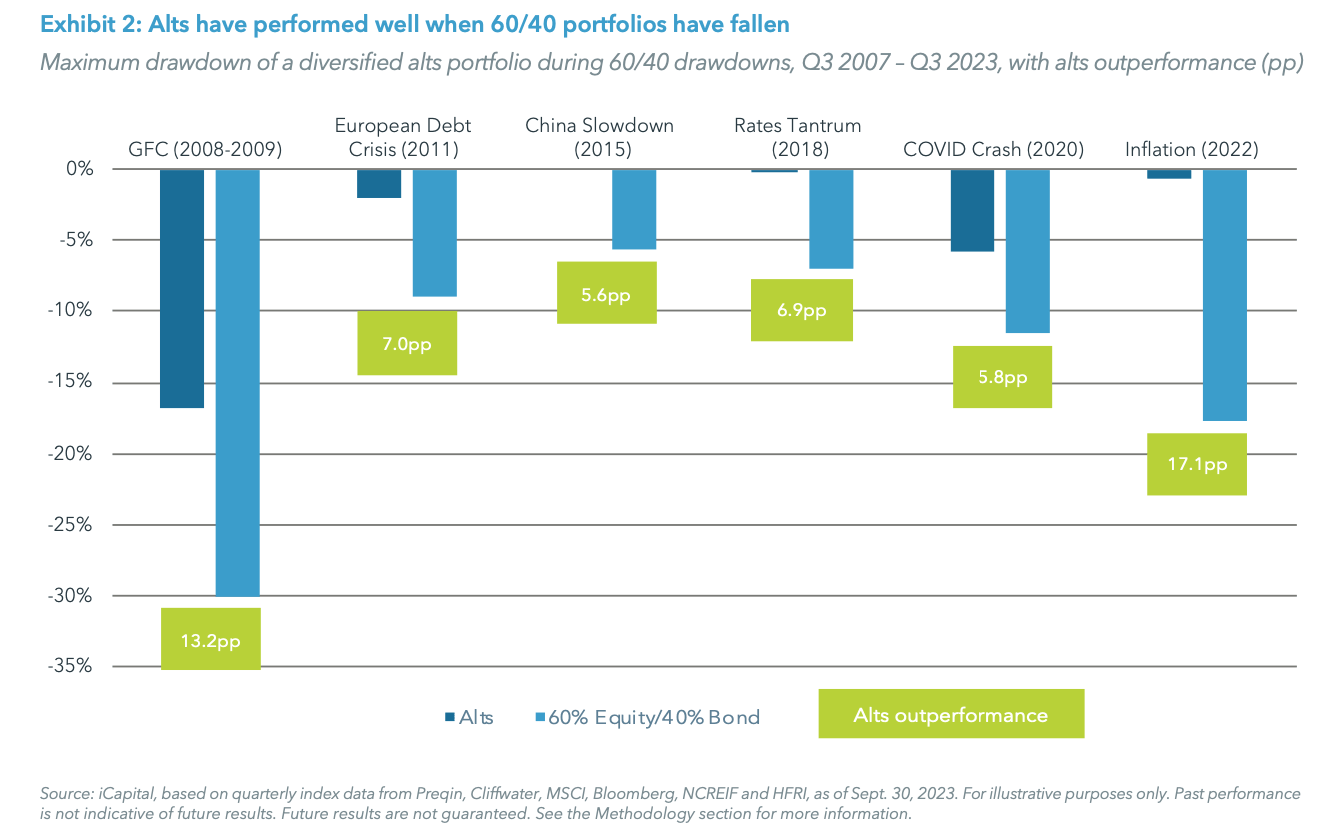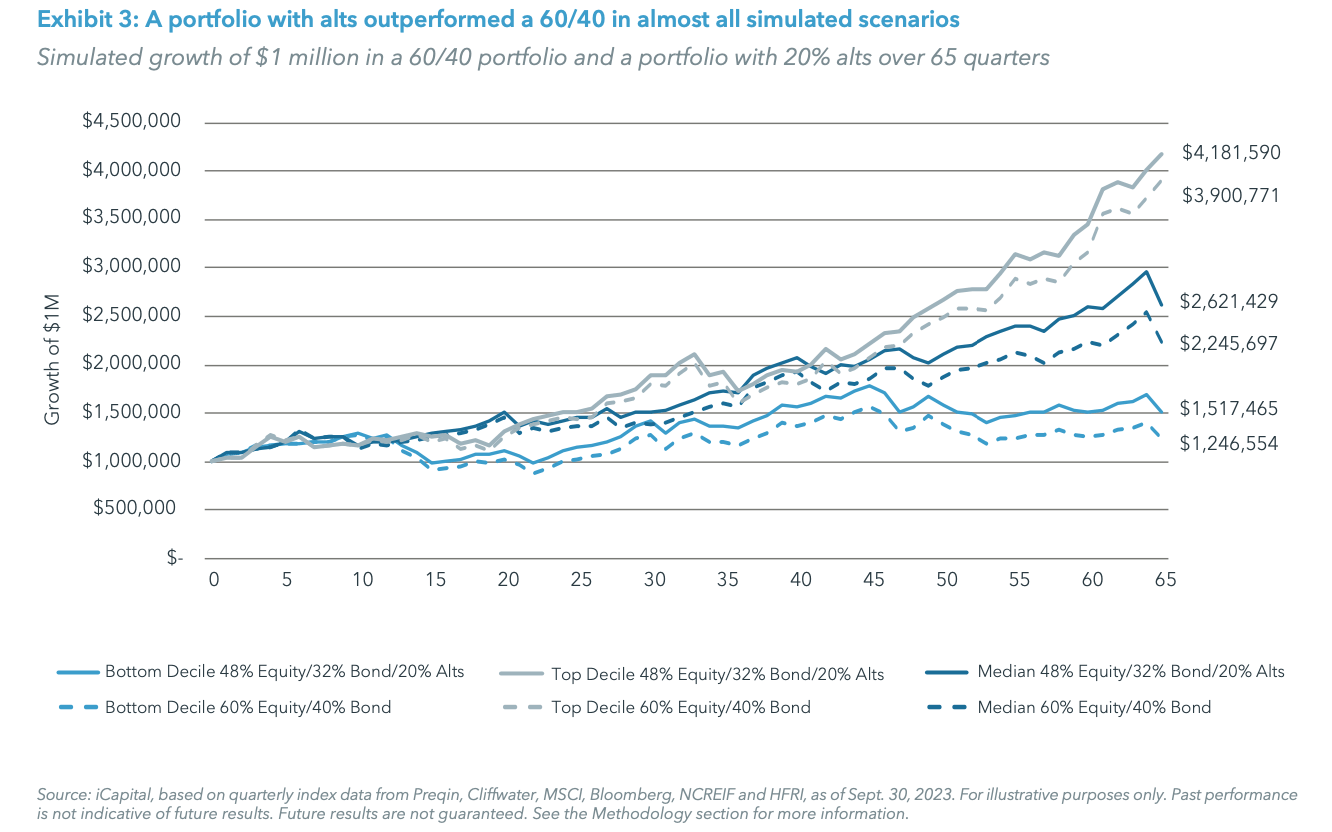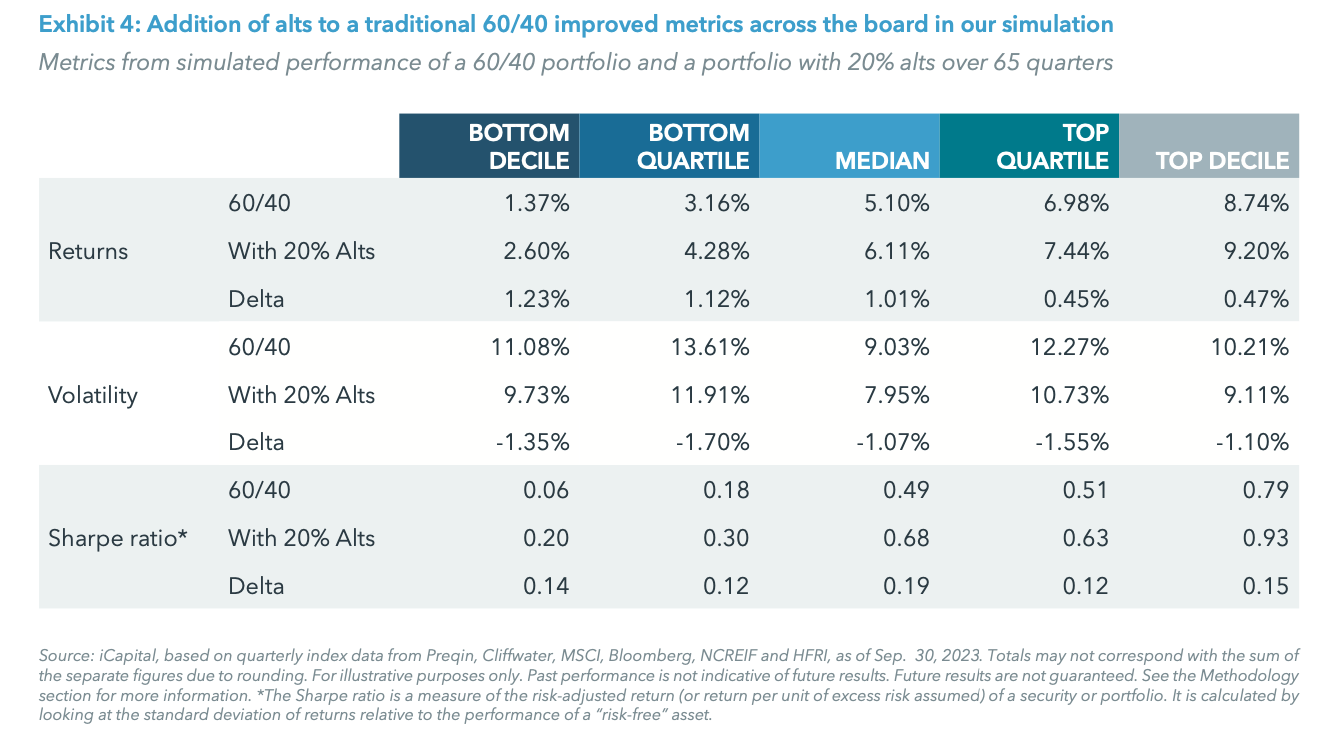KEY TAKEAWAYS
• Historical analysis shows that a 20% allocation to alternative investments (alts) in a traditional 60% equity/40% bond portfolio would have lifted annualized returns nearly an entire percentage point over the last ~16 years, while reducing volatility.
• Our analysis of adding alts to a traditional 60/40 portfolio found improved returns in 98.6% of modeled scenarios.
• Alts outperformed a traditional 60/40 portfolio most strongly during weaker markets, strengthening the case for incorporating alts should returns from traditional public portfolios continue to slow from historically strong levels.
As the recent era of easy money is firmly in the rearview and global economies reel from the impact of inflation, higher rates, uncertainty around future growth, and geopolitical disruptions, a traditional 60% equity/40% bond allocation has come under stress. In 2022, a traditional 60/40 allocation would have returned -18.8%, and the negative correlation between stocks and bonds showed signs of reversing, as stocks (-21.1%) and bonds (-15.7%) moved downward in lockstep.1 Through September 30, 2023, the traditional portfolio has fared better, returning 5.8%, however, the correlation between stocks and bonds have only marched higher, reaching .86 on a 12-month rolling basis through December 31, 2023.2 Furthermore, over that same period, the fixed income component of a 60/40 portfolio contributed 15% of portfolio volatility, versus just 5% historically.3
If equities and bonds no longer provide an appropriate hedge against each other, then the need to find investments that can becomes even more pressing. However, as our detailed analysis will demonstrate, even before this apparent shift in the stock-bond correlation, building alts exposure into portfolios was already valuable. According to historical data, a portfolio with a 20% allocation to alts would have improved overall returns and reduced drawdowns in times of market stress compared to a traditional 60/40 portfolio.4 Furthermore, a simulation of outcomes, based upon historical performance data, suggests that downside risk reduction and higher returns are persistent benefits of adding alts to a portfolio.5
HISTORY DOESN’T REPEAT ITSELF, BUT IT OFTEN RHYMES
Hindsight – as the saying goes – is 20:20. And hindsight shows that a small allocation to a combination of alternative asset classes and strategies would have notably improved portfolio performance over the last ~16 years, which is the full time period in which there is historical data covering all the asset classes in our portfolio with an alts allocation (See Exhibit 1).6 The portfolio in our analysis assumes an allocation of 20% to alts by reallocating proportionately from equity and fixed income.7 The alts component is composed of 8% private equity, 8% private credit, 2% private real estate, and 2% hedge funds. For a full breakdown of how we arrived at this allocation, please see the Methodology section.
As Exhibit 1 shows, an investment of $1 million in the third quarter in 2007 would have returned nearly $2.5 million with a 20% allocation to alts — over $320,000 more than a traditional 60/40 approach.8 It is noteworthy that the alts allocation on its own would have returned more than $4.1 million, or nearly double the return from the traditional portfolio.9 Put another way, adding alts to a traditional 60/40 portfolio increased the total return by nearly 15%, translating to annualized returns nearly a whole percentage point higher.10
Just as importantly, the addition of alts simultaneously reduced volatility.11 While volatility and risk are not necessarily the same thing – the former is simply a measure of the magnitude of movements in both directions over time – lower volatility often contributes to a reduction in measures of risk, such as drawdowns or maximum loss. Alts have several attributes that can allow them to reduce volatility.12
Exhibit 2 highlights how, in isolation, the alts component of our modeled portfolio performed during drawdowns in a 60/40 portfolio.13
Alts’ ability to provide downside protection is reflected in the fact that they have, on average, captured only 22% of declines of traditional stock and bond portfolios over the drawdown periods in Exhibit 2.14 Those benefits are notable when integrating a 20% alts allocation into a traditional portfolio.
Incorporating alts would have reduced portfolio losses by approximately 17%, on average, during periods of public market decline – an almost one-for-one reduction for each percentage allocation to alts.15
A PERENNIAL ALTERNATIVE TO A 60/40
While it is clearly powerful to show how alts could have improved portfolio performance in the past, we wanted to more firmly establish that alts are additive irrespective of the market environment or performance of the traditional portfolio.
To do so, we used a Monte Carlo simulation to examine the relative performance of the portfolio with a 20% alts allocation across thousands of theoretical return paths. This involved randomly and repeatedly selecting a quarter from our historical data and finding the actual returns during each of those periods for both a traditional 60/40 portfolio and our 48/32/20 alts portfolio. The Monte Carlo simulation then repeats the process 10,000 times to create, in effect, 10,000 different ~16-year potential alternate return scenarios for our portfolios. These scenarios range from very good (8.7% top decile annualized 60/40 portfolio returns) to very bad (1.4% bottom decile annualized returns). The median ~16-year return of a 60/40 allocation in our simulation was 5.1%, which is nearly identical to the historical 60/40 portfolio return.16
This type of simulation allows us to analyze the impact of alts on a 60/40 portfolio in a wide range of market environments. While the outcomes are hypothetical, it is important to reiterate that the performance data is built from actual historical returns for both traditional and alternative assets. The Monte Carlo simulation found that the portfolio with a 20% allocation to alts outperformed a traditional 60/40 portfolio 9,864 out of 10,000 runs, i.e., 98.6% of the time (See Exhibit 3).17
Exhibit 3 compares the simulated outcomes of the portfolio with a 20% allocation to alts and a traditional portfolio at several major percentile levels. Looking at these specific levels allows us to better understand the impact of alts in both bull and bear markets. The portfolio with a 20% allocation to alts would have cumulatively produced 7.2% higher returns after 65 quarters at the top decile level of the 60/40 portfolio returns, 16.7% higher returns at the median level, and 21.7% higher returns at the bottom decile level.18 While the inclusion of alts was beneficial to a 60/40 portfolio across the board, the greater outperformance at the lower end of the outcome range plainly underscores the protection alts can offer in more challenging environments. Exhibit 4 summarizes what this translates to in terms of annualized returns, volatility, and overall portfolio risk-return. In simple terms, the 48/32/20 alts portfolio created improvements – “deltas” – on each of these metrics across the simulated performance levels.19
The addition of 20% alts boosted returns by 101 basis points (bps) annually in the median outcome, and by as much as 123 bps at the bottom decile level.20 Moreover, the higher returns were not associated with higher risk. Rather, portfolio volatility decreased by 107 bps at the median level, and by an even larger degree at other levels. A combination of higher returns and lower volatility are reflected in an improvement in the Sharpe ratio for the portfolio with a 20% allocation to alts at all major percentile levels. The Sharpe ratio measures the expected return relative to risk and is an important consideration in portfolio construction.
The Monte Carlo simulations show us that, whether a 60/40 portfolio performed strongly or poorly, an allocation to alts would have made that performance better.
History suggests that traditional 60/40 investors will be unable to continually rely on a market environment as positive as we have witnessed in recent years. From the end of the Global Financial Crisis when the market turned upward in the second quarter of 2009, through the end of December 2021, a 60/40 portfolio returned an annualized 9.7%.21 By comparison, since the turn of the millennium, the annual return from a 60/40 portfolio has been 5.0%.22
The performance boost from alts has been greatest in the traditional 60/40 portfolio’s times of weakness. So, if you believe that returns from a traditional stock and bond portfolio will slow (and even a reversion to the mean would be a significant step down) the argument for incorporating alts becomes even stronger.
ALTERNATIVE, BUT NO LONGER NICHE
Following this analysis, the next natural question is how to incorporate alts into a portfolio. However, the term “alternatives” creates a sense that these investments are exotic and evokes images of opaque, pricey products with high minimums and administrative burdens.
But steep investment thresholds and administrative complexity no longer stand as barriers to allocating to alts. Ongoing product and technological innovation in the high-net-worth (HNW) investor space has helped simplify various investment processes, with platforms that provide education, streamline administration, and automate reporting. Further, these innovations have, in a virtuous cycle with rising competition, driven the entry of a wider selection of high-caliber managers into the individual investor space, and placed downward pressure on fees.23
While they may be called alternative, alts are no longer exclusive or niche. Private market assets under management are currently valued at over $13 trillion.24 With more investors seeking uncorrelated sources of return to help mitigate risk in a traditional 60/40 portfolio, these investments will likely, and necessarily, become ubiquitous components of a well- balanced portfolio.
METHODOLOGY
Data used in this paper was collected from Preqin, Cliffwater, MSCI, Bloomberg, NCREIF, and HFR, as of September 30, 2023. Past performance is not indicative of future results. Future results are not guaranteed. Quarterly total returns data taken from:
Traditional 60/40 Portfolio
Public equities (60%): MSCI ACWI (All Country World Index), which is designed to represent performance of the full opportunity set of large- and mid-cap stocks across 23 developed and 24 emerging markets.
Bonds (40%): Bloomberg US Aggregate Bond Index, which is a broad base, market capitalization-weighted bond market index. The index includes Treasury securities, government agency bonds, mortgage-backed bonds, corporate bonds, and several foreign bonds traded in the United States.
Diversified Alts Portfolio
Private equity (40%): Preqin’s PE Index consists of funds within Preqin’s database that are categorized within one of the following sub strategies: Balanced, Buyout, Co-Investments, Direct Secondaries, Fund of Funds, Growth, Hybrid, PIPE, Secondaries, Turnaround, and Venture Capital.
Private credit (40%): Cliffwater Direct Lending Index, which is an asset-weighted index of over 10,000 directly originated middle market loans totaling $247 billion as of June 30, 2022.
Real Estate (10%): A modified NCREIF-ODCE (Open End Diversified Core Equity) Index, which is a capitalization- weighted, gross of fee, time-weighted return index for real estate investments. Modified with a higher return, greater risk profile to better reflect the nature of private real estate investments, which have greater exposure to the core-plus segment of the market.
Hedge Funds (10%): HFRI Fund Weighted Composite Index, which is a global index comprised of single-manager funds that report to HFR Database, weighted according to the AUM reported by each fund for the prior month.
Portfolio with 20% Allocation to Alts
Indices as above, with allocation of 48% public equities, 32% bonds, 8% private equity, 8% private credit, 2% real estate, and 2% hedge funds.
iCapital determined the alts portfolio asset class weightings based on Mean-Variance Optimization (MVO). MVO identifies the optimal portfolio weights to minimize risk for a given return or maximize return per unit of risk. iCapital ran the portfolio with six portfolio components: stocks, bonds, private equity, private credit, real estate, and hedge funds. The stock and bond allocations were fixed at 48% and 32%, respectively, while the alts components (20% in aggregate) were constrained to 8% maximum and 2% minimum individual weightings. The optimal portfolio resulted in an allocation of 48% stocks, 32% bonds, 8% private equity, 8% private credit, 2% real estate, and 2% hedge funds.
Monte Carlo Simulation
A Monte Carlo simulation is a statistical technique used to estimate possible outcomes of events. For our Monte Carlo simulation, we utilized a bootstrapping methodology. The bootstrap is a type of non-parametric Monte Carlo Simulation approach that resamples from a single dataset to create many simulated samples (versus parametric approaches that simulate samples from defined parameters). The advantage of bootstrapping is that it makes no assumptions about the underlying distribution or its properties. Because bootstrapping involves resampling from known data, future paths will have the same basic historical return realizations that have been experienced in the past. For example, if the historical data does not have a 20% down month, bootstrapping cannot generate one. Bootstrapping typically involves resampling with replacement, i.e., all values in the dataset have an equal probability of being selected, which means a value can be selected multiple times.
ENDNOTES
1. eVestment, based on monthly returns, as of Dec. 31, 2023.
2. eVestment, based on monthly returns, as of Dec. 31, 2023.
3. eVestment, based on monthly returns, as of Dec. 31, 2023. Historically refers to the period between Jan. 2000 – Dec. 2023.
4. See Exhibits 1, 2, and 3.
5. See Exhibits 4 and 5.
6. iCapital, based on quarterly index data from Preqin, Cliffwater, MSCI, Bloomberg, NCREIF and HFRI, as of Sept. 30, 2023. See the Methodology for further information.
7. This results in an allocation of 48% to stocks, 32% to bonds, and 20% to alts. The 20% allocation to alts is purely illustrative. Optimal individual allocations will vary based upon resources, specific goals, risk tolerance, liquidity needs, and other factors.
8. iCapital, based on quarterly index data from Preqin, Cliffwater, MSCI, Bloomberg, NCREIF and HFRI, as of Sept. 30, 2023. See the Methodology for further information.
9. iCapital, based on quarterly index data from Preqin, Cliffwater, MSCI, Bloomberg, NCREIF and HFRI, as of Sept. 30, 2023. See the Methodology for further information.
10. iCapital, based on quarterly index data from Preqin, Cliffwater, MSCI, Bloomberg, NCREIF and HFRI, as of Sept. 30, 2023. See the Methodology for further information.
11. iCapital, based on quarterly index data from Preqin, Cliffwater, MSCI, Bloomberg, NCREIF and HFRI, as of Sept. 30, 2023. See the Methodology for further information.
12. iCapital, What are Alternative Investments?, May 20, 2022.
13. iCapital, based on quarterly index data from Preqin, Cliffwater, MSCI, Bloomberg, NCREIF and HFRI, as of Sept. 30, 2023. See the Methodology for further information.
14. iCapital, based on quarterly index data from Preqin, Cliffwater, MSCI, Bloomberg, NCREIF and HFRI, as of Sept. 30, 2023. See the Methodology for further information.
15. iCapital, based on quarterly index data from Preqin, Cliffwater, MSCI, Bloomberg, NCREIF and HFRI, as of Sept. 30, 2023. See Methodology for further information.
16. eVestment, based on monthly returns, as of Dec. 31, 2023.
17. iCapital, based on quarterly index data from Preqin, Cliffwater, MSCI, Bloomberg, NCREIF and HFRI, as of Sept. 30, 2023. See Methodology for further information.
18. iCapital, based on quarterly index data from Preqin, Cliffwater, MSCI, Bloomberg, NCREIF and HFRI, as of Sept. 30, 2023. See Methodology for further information.
19. iCapital, based on quarterly index data from Preqin, Cliffwater, MSCI, Bloomberg, NCREIF and HFRI, as of Sept. 30, 2023. See Methodology for further information.
20. iCapital, based on quarterly index data from Preqin, Cliffwater, MSCI, Bloomberg, NCREIF and HFRI, as of Sept. 30, 2023. See Methodology for further information.
21. eVestment, based on quarterly returns, as of Dec. 31, 2023.
22. eVestment, based on quarterly returns, as of Dec. 31, 2023.
23. iCapital, The Future is Evergreen: The Next Generation of Private Market Funds, Jan. 11, 2024.
24. Preqin, Future of Alternatives 2028, as of Oct. 27, 2023.
IMPORTANT INFORMATION
The material herein has been provided to you for informational purposes only by Institutional Capital Network, Inc. (“iCapital Network”) or one of its affiliates (iCapital Network together with its affiliates, “iCapital”). This material is the property of iCapital and may not be shared without the written permission of iCapital. No part of this material may be reproduced in any form, or referred to in any other publication, without express written permission of iCapital.
This material is provided for informational purposes only and is not intended as, and may not be relied on in any manner as, legal, tax or investment advice, a recommendation, or as an offer or solicitation to buy or sell any security, financial product or instrument, or otherwise to participate in any particular trading strategy. This material does not intend to address the financial objectives, situation, or specific needs of any individual investor. You should consult your personal accounting, tax and legal advisors to understand the implications of any investment specific to your personal financial situation.
ALTERNATIVE INVESTMENTS ARE CONSIDERED COMPLEX PRODUCTS AND MAY NOT BE SUITABLE FOR ALL INVESTORS. Prospective investors should be aware that an investment in an alternative investment is speculative and involves a high degree of risk. Alternative Investments often engage in leveraging and other speculative investment practices that may increase the risk of investment loss; can be highly illiquid; may not be required to provide periodic pricing or valuation information to investors; may involve complex tax structures and delays in distributing important tax information; are not subject to the same regulatory requirements as mutual funds; and often charge high fees. There is no guarantee that an alternative investment will implement its investment strategy and/or achieve its objectives, generate profits, or avoid loss. An investment should only be considered by sophisticated investors who can afford to lose all or a substantial amount of their investment.
iCapital Markets LLC operates a platform that makes available financial products to financial professionals. In operating this platform, iCapital Markets LLC generally earns revenue based on the volume of transactions that take place in these products and would benefit by an increase in sales for these products.
The information contained herein is an opinion only, as of the date indicated, and should not be relied upon as the only important information available. Any prediction, projection or forecast on the economy, stock market, bond market or the economic trends of the markets is not necessarily indicative of the future or likely performance. The information contained herein is subject to change, incomplete, and may include information and/or data obtained from third party sources that iCapital believes, but does not guarantee, to be accurate. iCapital considers this third-party data reliable, but does not represent that it is accurate, complete and/or up to date, and it should not be relied on as such. iCapital makes no representation as to the accuracy or completeness of this material and accepts no liability for losses arising from the use of the material presented. No representation or warranty is made by iCapital as to the reasonableness or completeness of such forward-looking statements or to any other financial information contained herein.
Securities products and services are offered by iCapital Markets, an SEC-registered broker-dealer, member FINRA and SIPC, and an affiliate of iCapital, Inc. and Institutional Capital Network, Inc. These registrations and memberships in no way imply that the SEC, FINRA, or SIPC have endorsed any of the entities, products, or services discussed herein. Annuities and insurance services are provided by iCapital Annuities and Insurance Services LLC, an affiliate of iCapital, Inc. “iCapital” and “iCapital Network” are registered trademarks of Institutional Capital Network, Inc. Additional information is available upon request.
©2024 Institutional Capital Network, Inc. All Rights Reserved. | 2024.01























